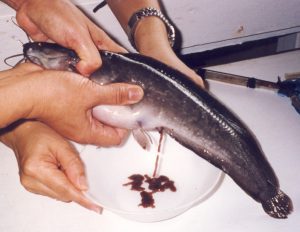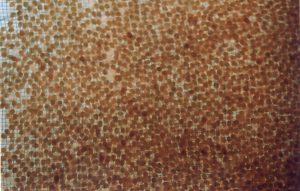Why CATFISH?
Catfish, Clarias spp. (hito, paltat, pantat, and ito locally) is one of the most important freshwater food fishes in Southeast Asia. Catfish farming does not require a large area, can thrive in poor water quality conditions, can be raised at high stocking densities using formulated diet, is not susceptible to diseases and less labor intensive.
How to breed and culture CATFISH?
Spawning

Macerating testes in a Petri dish Depending on the larvae requirement, 100-150 g or 6-8 months old catfish broodstock (2:5, male to female ratio) are placed in separate holding containers.
- Determine the total body weight (BW) of female catfish to be spawned artificially and prepare hormones to be used. Pituitary glands, human chorionic gonadotropin (HCG), luteinizing hormone-releasing hormone analogue (LHRHa) + pimoside (PIM), Ovaprim, or Ovatide may be used. Injection dosages as administered to female broodstock are as follows:
- 1 homogenized pituitary gland/100 g BW
- 400 I.U. human chorionic gonadotropin (HCG)/100 g BW
- 0.005 mg luteinizing hormone-releasing hormone analogue (LHRHa) + 0.1 mg pimoside (PIM)/100 g BW
- 0.02 mL Ovaprim/100 g BW
- 0.02-0.05 mL Ovatide/100 g BW

Stripping of female catfsh Anaesthetize the female catfish by placing them into a pail with 10 liters of tap water mixed with 5 mL anaesthesia (2-phenoxyethanol). Pat dry the fish and inject hormone to dorsal musculature.
- Anaesthetize males, pat dry, make an L-shape cut to open the abdomen and take out the testes. Place this in a Petri dish, rinse with 0.9% NaCl, blot-dry, transfer to a clean dish, macerate, and add 0.9% NaCl to obtain milt solution. Add more 0.9% NaCl, if needed, to make sure that eggs are totally exposed to the sperm.
- Press the abdomen of the female to strip eggs into a clean, dry bowl or basin. Pour the milt solution into the bowl or basin and mix for 30 to 60 seconds using a feather (one male catfish i.e. full of milt can fertilize eggs of two female catfish). Add 5 mL tap water, mix further to ensure fertilization and transfer fertilized eggs to a scoop net. Wash with running tap water to remove excess milt. Spread the eggs on a net tray inside a flow-through hatching trough or basin. Maintain water level of about 10 cm inside the trough or basin.
- Observe if most larvae have hatched 24-30 hours after fertilization and incubation. Feed larvae with natural food organisms like Moina neonates, Artemia nauplii or Tubifex worms.
Larval rearing

Catfsh larvae Transfer 4-6 day-old larvae into tanks with 10-15 cm water level. Stock at 100-150 larvae/L. Aerate mildly, place shelters at the bottom, and feed larvae with newly-hatched Artemia nauplii at 10 individuals/mL thrice a day. Change about 30% of the water in the larval rearing tanks daily.
- Feed 7-10 day-old larvae with the cladoceran Moina or Daphnia (water fleas) at 5-10 individuals/mL thrice a day for another 4 days; otherwise, continue feeding Artemia nauplii.
- Start feeding the larvae with SEAFDEC/AQD formulated diet in the morning of day 10 and give natural food organisms in the afternoon. Change 50% of water daily from hereon.
- Continue giving catfish feeds until larvae can be transferred to a nursery system on day 15.
Grow-out in ponds

Draining and levelling of a pond Drain, level, and dry pond bottom for 2-3 weeks. Repair gates and screens. Check dike for leaks and seepages. Eradicate unwanted species using lime. Apply lime at 500-1,000 kg/ha. Apply cow or chicken manure at 500-1,000 kg/ha. Install a fence 20-30 cm high along the perimeter dike. Let in water at an initial depth of 10-20 cm and allow to settle for 7 days. Apply inorganic fertilizer 16-20-0 at 50 kg/ha and urea at 25 kg/ha. Increase water depth to 50-60 cm.
- Select healthy and uniformly sized fingerlings with average body weight of 3-5 grams. Acclimate fingerlings before stocking. Stock fingerlings at 5-20 pcs/m2.
- Give catfish feeds twice daily at 5% of the total biomass for the first month, decreasing by 0.5% every month until the fifth month of culture. Trash fish, chicken entrails mixed with rice bran, kitchen refuse or stale bread may also be given to catfish.

Selection of healthy and uniform-sized fingerlings Follow the usual pond routine of stock sampling, water monitoring, survival monitoring & observing for signs of disease or abnormality, and farm records keeping.
- Prior to harvest, cook some catfish samples to detect off-flavor. If detected, delay the harvest and determine the cause. Replenish 60-80% of pond water for 2-3 days. Hold harvested fish in tanks with running water for a few days.
- Harvest fish when they reach 80-200 grams after 3-5 months of culture. Catfish are marketed live.
Is CATFISH seed production profitable?
Technical assumptions for seed production
| Item | Broodstock | Hatchery |
| Project duration (years) | 5 | 5 |
| Days of culture/crop | 15 | |
| No. of runs/year | 12 | 10 |
| No. of tank or pond | 4 ponds | 12 tanks |
| Size of tank or pond | 100 m2 pond | 1-ton tank |
| Age of fish (days) | at least 180 | 4-15 |
| Feeding rate (% body weight) | 3 | 50 |
| Stocking density | 10-15 pcs/m2 | 100 pc/liter |
| Survival rate (%) | 0 for males; 90 for females | 25 |
| Number of fish/per run (pcs) | 20 males, 50 females | 120,000 |
| Selling price of fry (PhP/pc) | 0.4 | |
| Gross sales per run (PhP) | 48,000 |
Costs-and-returns analysis (per run) (as of 2017)
| Total variable cost (PhP) | 8,560 |
| Total fixed cost (PhP) | 15,204 |
| Income (PhP) | 24,236 |
| Internal rate of return (%) | 158 |
| Return-on-investment (%) | 159 |
| Payback period (year) | 0.59 |
| Break-even price (PhP) | 0.2 |
| Break-even production (pcs) | 600,832 |
Is CATFISH farming profitable?
Technical assumptions for grow-out in ponds
| Item | |
| Project duration (years) | 5 |
| Total pond area (m2) | 1,000 |
| Stocking density (pcs/m2) | 10 |
| Total stock (pcs/crop) | 10,000 |
| Number of crops per year | 2 |
| Average body weight at harvest (g) | 110 |
| Feed conversion ratio | 2.3 |
| Target production per crop (kg) | 770 |
| Price/kg (PhP) | 130 |
| Gross sales per crop (PhP) | 100,100 |
Costs-and-returns analysis (per crop) (as of 2017)
| Total variable cost (PhP) | 69,089 |
| Total fixed cost (PhP) | 8,040 |
| Net income (PhP) | 22,971 |
| Internal rate of return (%) | 148 |
| Return-on-investment (%) | 80 |
| Payback period (year) | 1.2 |
| Break-even price (PhP) | 100 |
| Break-even production (pcs) | 593 |
Reference:
SEAFDEC Aquaculture Department. (2017). Catfish hatchery and grow-out [Brochure]. Tigbauan, Iloilo, Philippines: Author.





please send me some source on how to start hito hatchery